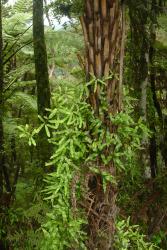Climbing ferns. Rhizomes creeping, bearing septate hairs. Fronds monomorphic, not articulated to rhizome; juvenile fronds of determinate growth; adult fronds twining and climbing with a wiry rachis of indeterminate growth. Stipes glabrous or hairy. Pinnae arising alternately on rachis, dividing pseudo-dichotomously with a dormant bud in the axil, glabrous or sparsely hairy. Fertile and sterile segments often markedly dimorphic. Veins free or reticulate without free included veinlets. Sporangia borne individually in two rows on marginal lobes of the fertile segments, not in sori, each covered by an antrorse subtending indusium-like flange, asymmetrically ovoid, attached laterally, with the annulus horizontal around the outward-pointing apex, dehiscing by a vertical longitudinal slit; spores maturing ±simultaneously; 128–256 spores per sporangium. Homosporous; spores trilete, tuberculate or verrucate, lacking chlorophyll.
A genus of about 30 species distributed throughout the tropics and subtropics, extending to temperate parts of Japan, China, eastern USA, New Zealand and southern Africa; about nine species in tropical and temperate America, four in Africa, 15 in south-east Asia, four in Australia and seven in the Pacific. One species endemic to New Zealand.
| Category | Number |
|---|---|
| Indigenous (Endemic) | 1 |
| Total | 1 |
The base chromosome number in Lygodium is given as x = 29, 30 by Smith et al. (2006) with n = 29, 30, 58, and 60, and 2n = 56, 112, 116 and 120 recorded by Kramer (1990).




